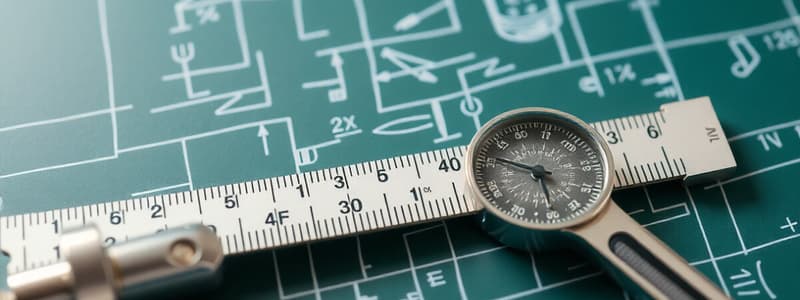Podcast
Questions and Answers
What is the main purpose of a vernier calliper?
What is the main purpose of a vernier calliper?
- To measure the distance between two symmetrical points (correct)
- To assess the weight of an object
- To measure temperature in environments
- To measure angles with high precision
Which part of the vernier calliper is utilized to measure internal lengths?
Which part of the vernier calliper is utilized to measure internal lengths?
- Outside Jaws
- Inside Jaws (correct)
- Depth Probe
- Main Scale (cm)
What geometry concept is illustrated by translating two vectors to form a parallelogram?
What geometry concept is illustrated by translating two vectors to form a parallelogram?
- Vector summation and difference (correct)
- Vector rotation
- Vector projection
- Vector normalization
How is the vector difference represented in the parallelogram constructed from two vectors?
How is the vector difference represented in the parallelogram constructed from two vectors?
Which measurement tool is typically used in combination with the tips of a vernier calliper?
Which measurement tool is typically used in combination with the tips of a vernier calliper?
Which part of the vernier calliper is specifically designed to measure depths?
Which part of the vernier calliper is specifically designed to measure depths?
In which fields is a vernier calliper commonly utilized?
In which fields is a vernier calliper commonly utilized?
When constructing a parallelogram using two vectors, what does the diagonal from the origin to the opposite corner represent?
When constructing a parallelogram using two vectors, what does the diagonal from the origin to the opposite corner represent?
Which of the following is NOT a source of systematic errors?
Which of the following is NOT a source of systematic errors?
What type of error is introduced when there is a zero error in an instrument?
What type of error is introduced when there is a zero error in an instrument?
Which of the following factors can systematically impact measurement results?
Which of the following factors can systematically impact measurement results?
In what situation would a thermometer reading lower than the actual body temperature be expected?
In what situation would a thermometer reading lower than the actual body temperature be expected?
Which of the following best describes random errors?
Which of the following best describes random errors?
What type of error might occur due to an individual's consistent bias while reading measurements?
What type of error might occur due to an individual's consistent bias while reading measurements?
What is the consequence of a worn-off measuring scale edge?
What is the consequence of a worn-off measuring scale edge?
What could cause a thermometer to read inaccurately at the boiling point of water?
What could cause a thermometer to read inaccurately at the boiling point of water?
What are fundamental or base units?
What are fundamental or base units?
Which of the following is NOT a base unit in the SI system?
Which of the following is NOT a base unit in the SI system?
How many base units are defined in the SI system?
How many base units are defined in the SI system?
Which of the following systems was NOT historically in widespread use for measurement?
Which of the following systems was NOT historically in widespread use for measurement?
What is the primary purpose of the International System of Units (SI)?
What is the primary purpose of the International System of Units (SI)?
Which base quantity is represented by the unit 'lumen'?
Which base quantity is represented by the unit 'lumen'?
Which of the following is true about derived units?
Which of the following is true about derived units?
What was the main reason for developing the SI system?
What was the main reason for developing the SI system?
What primarily differentiates vector quantities from scalar quantities?
What primarily differentiates vector quantities from scalar quantities?
Which operation cannot be performed with vector quantities?
Which operation cannot be performed with vector quantities?
What is required to accurately draw vectors in a plane following the geometric approach?
What is required to accurately draw vectors in a plane following the geometric approach?
The parallelogram rule is used for what purpose in vector analysis?
The parallelogram rule is used for what purpose in vector analysis?
What complicates the addition of vectors compared to scalar addition?
What complicates the addition of vectors compared to scalar addition?
Which of the following is NOT considered a vector quantity?
Which of the following is NOT considered a vector quantity?
In a two-dimensional plane, what must be applied to calculate vector magnitudes and directions after determining resultant vectors?
In a two-dimensional plane, what must be applied to calculate vector magnitudes and directions after determining resultant vectors?
When combining vectors using the laws of algebra, which statement is accurate?
When combining vectors using the laws of algebra, which statement is accurate?
What is the formula used to calculate the mean absolute error (∆amean)?
What is the formula used to calculate the mean absolute error (∆amean)?
In the context of measurement errors, what does the relative error represent?
In the context of measurement errors, what does the relative error represent?
How is the percentage error (δa) calculated from the relative error?
How is the percentage error (δa) calculated from the relative error?
Given the periods of 2.63 s, 2.56 s, 2.42 s, 2.71 s, and 2.80 s, what is the mean period of oscillation (Tmean)?
Given the periods of 2.63 s, 2.56 s, 2.42 s, 2.71 s, and 2.80 s, what is the mean period of oscillation (Tmean)?
When measuring the period of a pendulum, which of the following represents the calculated absolute error for the reading of 2.56 s?
When measuring the period of a pendulum, which of the following represents the calculated absolute error for the reading of 2.56 s?
If the mean absolute error (∆amean) is calculated as 0.11 s and the mean value (amean) is 2.62 s, what is the relative error (δa)?
If the mean absolute error (∆amean) is calculated as 0.11 s and the mean value (amean) is 2.62 s, what is the relative error (δa)?
What is the percentage error if the relative error is calculated as 0.04?
What is the percentage error if the relative error is calculated as 0.04?
What is the absolute error for the measurement of 2.80 s when the mean period is 2.62 s?
What is the absolute error for the measurement of 2.80 s when the mean period is 2.62 s?
Flashcards are hidden until you start studying
Study Notes
Units and Measurements
- Measurement of physical quantities involves comparison with internationally accepted reference standards called units.
- Physical quantities are expressed with numerical values paired with units, allowing for a concise description.
- Fundamental units are those that describe base quantities; derived units are combinations of these base units.
- A complete system, including both base and derived units, is termed a system of units.
International System of Units (SI)
- The SI was established to standardize measurements globally, developed in 1971 by the General Conference on Weights and Measures.
- Prior systems included CGS (centimetre, gram, second), FPS (foot, pound, second), and MKS (metre, kilogram, second).
- SI units are crucial for scientific, technical, industrial, and commercial applications.
Scalars and Vectors
- Scalar quantities have magnitude only, e.g., temperature, mass, and energy, and can be added or subtracted like regular numbers.
- Vector quantities have both magnitude and direction, e.g., displacement, velocity, and force—represented mathematically as vectors.
- Vectors can be added using geometric methods, such as the parallelogram rule to find their resultant.
Parallelogram Rule of Vector Addition
- To add two vectors geometrically, translate one vector to the origin of another, forming a parallelogram.
- The diagonal of the parallelogram represents the resultant vector.
- The other diagonal indicates the difference between the two vectors.
Vernier Calliper
- A device for measuring distances between opposing sides, useful in fields like engineering and woodworking.
- Components include:
- Outside Jaws: Measure external lengths
- Inside Jaws: Measure internal lengths
- Depth Probe: Measures depth
- Main Scale: Available in cm and inches
- Vernier Scale: Available in cm and inches
Errors in Measurement
-
Systematic Errors: Consistently biased towards one direction due to factors like:
- Instrumental Errors: Flaws in design or calibration (e.g., thermometer miscalibration).
- Imperfections in technique: External conditions affecting the measurement.
- Personal Errors: Bias or carelessness by the observer.
-
Random Errors: Occur unpredictably during measurements and vary in sign and magnitude.
-
Absolute Error: The measure of inaccuracy without reference to the true value.
-
Relative Error: Ratio of mean absolute error to the mean value of the measured quantity.
Error Calculation
- Percentage Error Calculation:
- Relative Error: ( \text{Relative Error} = \frac{\Delta a_{mean}}{a_{mean}} )
- Percentage Error: ( \delta a = \left(\frac{\Delta a_{mean}}{a_{mean}}\right) \times 100% )
- Example of period of oscillation in a pendulum illustrates how to calculate absolute, relative, and percentage errors.
Studying That Suits You
Use AI to generate personalized quizzes and flashcards to suit your learning preferences.




